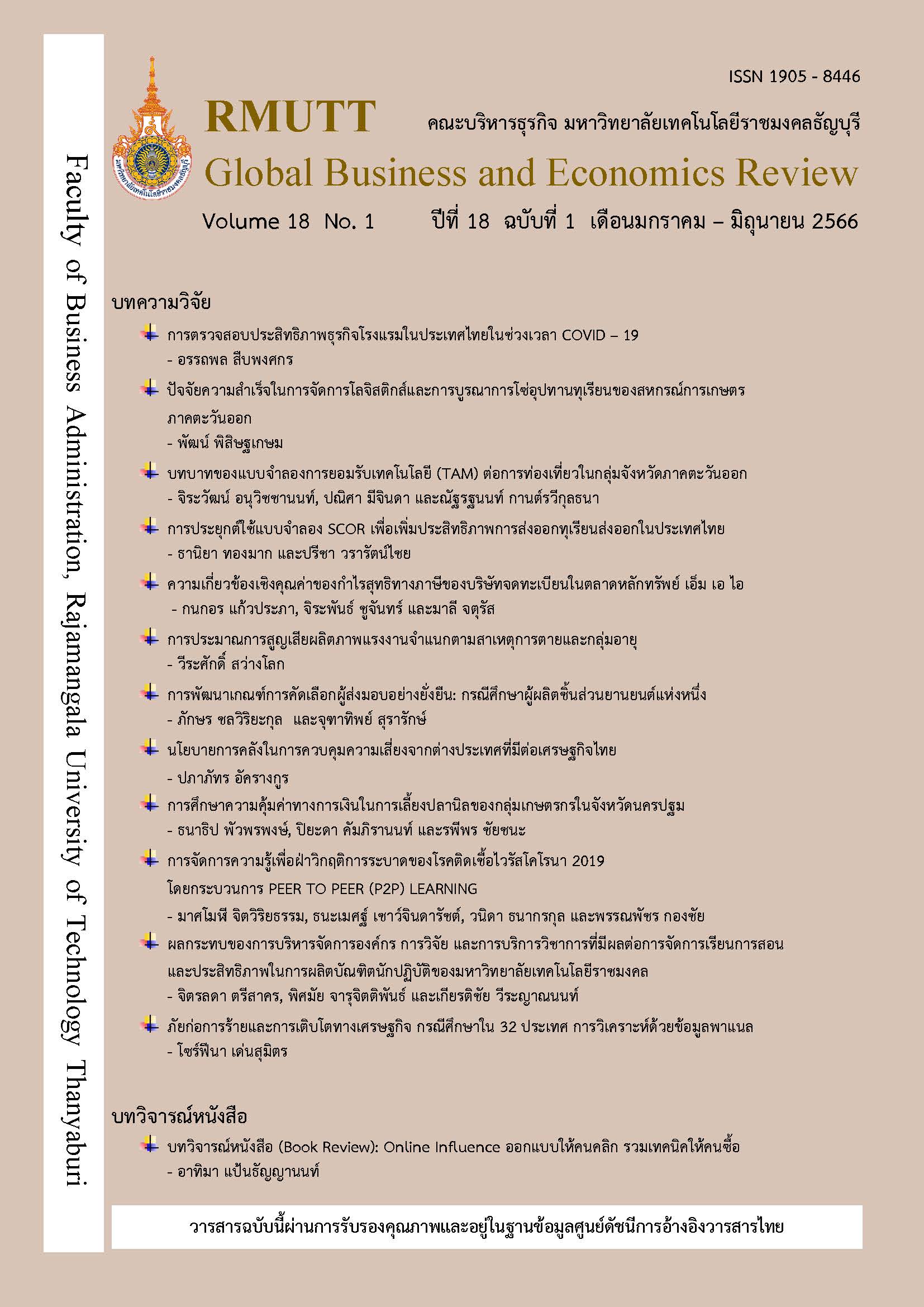AN ESTIMATION OF LABOR PRODUCTIVITY LOSS CLASSIFIED BY CAUSE OF DEATH AND AGE GROUP
Keywords:
Labor Productivity Loss, Cause of death, International Classification of DiseasesAbstract
This study has two objectives: 1) to measure labor productivity loss from 2004 to 2021 and 2) to estimate labor productivity loss from 2022 to 2031, classified by cause of death and age group. Cause of death here means death from disease, disorder, or injury from events such as accidents, physical harm, etc. This is a macro measure of labor productivity loss, using discrete data and comparing partial factors of production. The results of the study reveal that the cause of death from all forms of malignant neoplasms generates the highest average labor productivity loss of 677.61 million dollars per year and a labor productivity loss rate of 10.68 percent per year. For deaths in the 55–59 age group, the average labor productivity loss is the highest at $329.23 million per year, and the average labor productivity loss rate is 10.13 percent per year. The aforementioned age group is close to retirement age but has significant work experience. In the estimation of labor productivity loss, the model coefficient of the change in trend over time shows low error, except when the death is caused by diseases of the circulatory system, genitourinary system, endocrine, nutritional and metabolic diseases, diseases of the blood and blood-forming organs, as well as certain disorders involving the immune mechanism. In this case, labor productivity loss is estimated from the average change rate. The estimation results show that labor productivity loss tends to increase in all causes of death and age groups.
References
กองยุทธศาสตร์และแผนงาน. (2565). สถิติสาธารณสุข พ.ศ.2564. นนทบุรี: สํานักงานปลัดกระทรวงสาธารณสุข กระทรวงสาธารณสุข.
กองเศรษฐกิจการแรงงาน. (2564). รายงานการศึกษาวิจัยแนวทางการเพิ่มผลิตภาพแรงงานเพื่อพัฒนาคุณภาพของผลิตภาพแรงงานไทย. กรุงเทพฯ: สำนักงานปลัดกระทรวงแรงงาน.
กัญทิยา ประดับบุญ, พุดตาน พันธุเณร และชญานินท์ ประทุมสูตร. (2557). การวิเคราะห์ต้นทุนทางเศรษฐศาสตร์ของการเกิดอุบัติเหตุทางถนนในกลุ่มผู้ประกันตนในระบบประกันสังคม. วารสารบริหารธุรกิจ เศรษฐศาสตร์และการสื่อสาร, 9(2), 108-123.
นงนุช จินดารัตนาภรณ์ และศุทธิดา ชวนวัน. (2563). ภาวะเจริญพันธุ์ที่ลดลงในประเทศไทยและประเทศในทวีปเอเชีย. วารสารสังคมศาสตร์และมนุษย์ศาสตร์, 46(2), 48-85.
บุษกร สีหรัตนปทุม. (2563). การ ป้องกันโรคหลอดเลือดสมองขาดเลือดเฉียบพลันสำหรับวัยทำงานที่สูบบุหรี่ในสถานประกอบการเขตเมือง. วชิรเวชสารและวารสารเวชศาสตร์เขตเมือง, 64(6), 419-428.
ปาริชาติ นิยมทอง. (2561). โรคมะเร็งปอดรู้เท่าทันป้องกันได้. วารสารโรงพยาบาลแพร่, 26(1), 61-80.
พะกาวัลย์ บุญโสธรสถิต. (2534) การสูญเสียผลิตภาพอันเนื่องจากอุบัติเหตุจากการทำงานในภาคอุตสาหกรรม: ศึกษาเฉพาะในเขตสมุทรปราการ. (วิทยานิพนธ์ปริญญามหาบัณฑิต, จุฬาลงกรณ์มหาวิทยาลัย).
วรลักขณ์ วิชพัฒน์. (2564). ปัจจัยที่เกี่ยวกับการตายและอัตราการรอดชีวิตในผู้ป่วยโรคมะเร็งปอดชนิดเซลล์ขนาดไม่เล็กระยะแพร่กระจายที่ได้รับการวินิจฉัยและรักษาที่โรงพยาบาลสระบุรี. วารสารกรมการแพทย์, 46(1), 182-192.
สำนักงานคณะกรรมการพัฒนาการเศรษฐกิจและสังคมแห่งชาติ. (2563). ผลกระทบของการเปลี่ยนแปลงทางประชากรในประเทศไทย. กรุงเทพฯ: กองทุนประชากรแห่งสหประชาชาติ (UNFPA).
สุมาลี สันติพลวุฒิ, อ้อทิพย์ ราษฎร์นิยม, รสดา เวษฎาพันธุ์, สมหมาย อุดมวิทิต และพงษ์เทพ มังคะลี. (2550). โครงการจัดทำสถิติผลิตภาพแรงงานภาคอุตสาหกรรม. กรุงเทพฯ: มหาวิทยาลัยเกษตรศาสตร์.
อุรชา จันทรภา และนันทชัย กานตานันทะ (2564). การพยากรณ์มูลค่าการส่งออกรถยนต์อุปกรณ์และส่วนประกอบของประเทศไทยด้วยวิธีอนุกรมเวลา. วารสารไทยวิจัยดำเนินงาน, 9(2), 12-20.
Chantith, C., Permpoonwiwat, C. K., & Hamaide, B. (2021). Measure of productivity loss due to road traffic accidents in Thailand. IATSS research, 45(1), 131-136.
Farshadfar, S., Ng, C., & Brimble, M. (2008). The relative ability of earnings and cash flow data in forecasting future cash flows: some Australian evidence. Pacific accounting review. Retrieved from https://www.emerald.com/insight/content/doi/10.1108/ 01140580810920236/full/html
OECD. (2001). Measuring productivity-OECD manual: Measurement of aggregate and industry-level productivity growth. Paris: Organisation for Economic Co-Operation and Development.
Oliva-Moreno, J. (2012). Loss of labour productivity caused by disease and health problems: what is the magnitude of its effect on Spain’s Economy?. The European journal of health economics, 13(5), 605-614.
Paileeklee, S., Kanato, M., Kaenmanee, S., & McGhee, S. M. (2010). Alcohol drinking behavior and economic cost incurred by users in Khon Kaen. Journal of the Medical Association of Thailand Chotmaihet Thangphaet, 93, S38-44.
Paisarn, W., Butakhiao, P., Chancharat, S., & Chancharat, N. (2019). Predicting future cash flows by earnings, cash flow from operation and accruals. Journal Humanities and Social Sciences, 39(3), 20–42.
Sawangloke, W., Santipollavut, S., & Thamma-Apiroam, R. (2019). Measurement and comparison of labour productivity in the Asean. RMUTT Global Business and Economics Review, 14(2), 77-98.
Sungkaew, P. (2020). Labor productivity loss in case of death in Thailand. International Journal of Economics & Business Administration (IJEBA), 8(2), 488-500.
Ungar, W. J., Coyte, P. C., & Pharmacy Medication Monitoring Program Advisory Board. (2000). Measuring productivity loss days in asthma patients. Health economics, 9(1), 37-46.
World Bank. (2023). Total Fertility Rate. Retrieved from https://data.worldbank.org/
Downloads
Published
How to Cite
Issue
Section
License
Copyright (c) 2023 วีระศักดิ์ สว่างโลก

This work is licensed under a Creative Commons Attribution-NonCommercial-NoDerivatives 4.0 International License.
The articles published in this journal are the intellectual property of their respective authors.
The views and opinions expressed in each article are solely those of the individual authors and do not reflect the positions of Rajamangala University of Technology Thanyaburi or any of its faculty members. All components and content of each article are the sole responsibility of the respective authors. In the event of any errors, the authors shall bear full responsibility for their own work.








